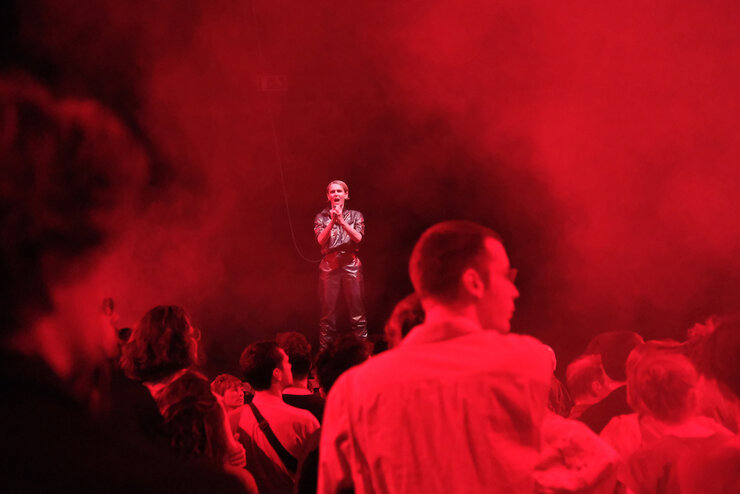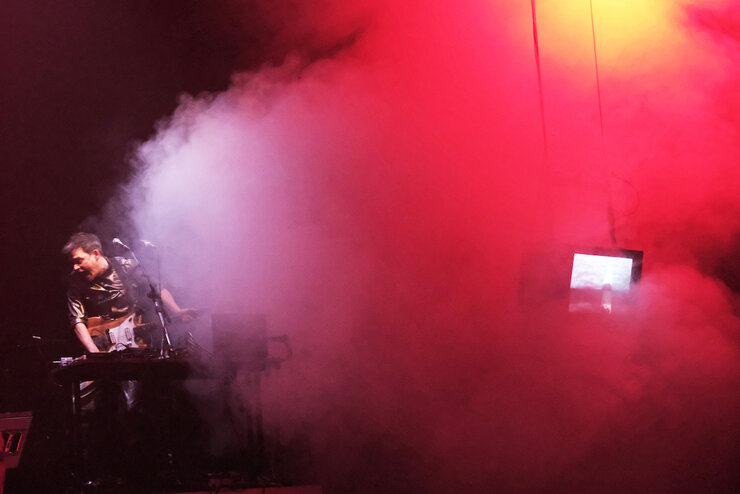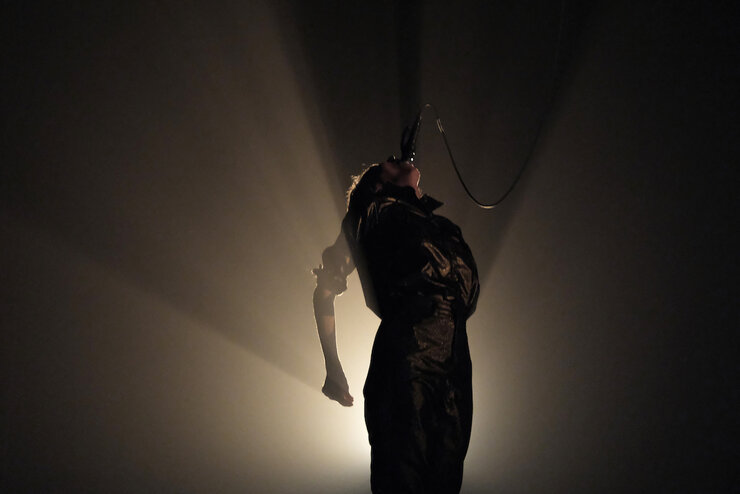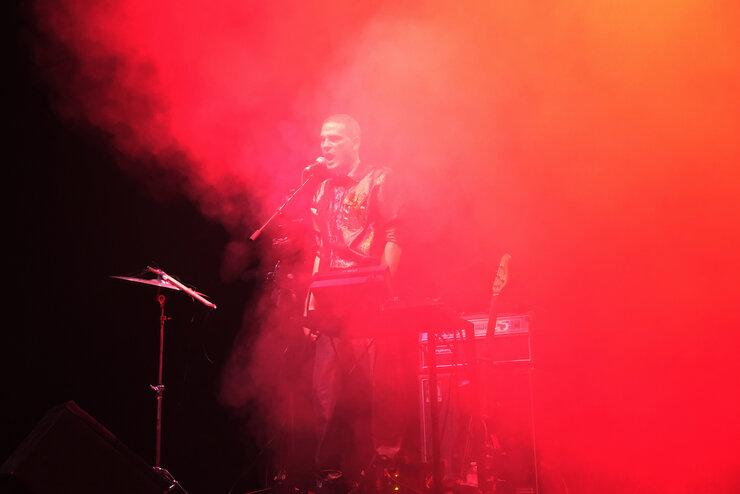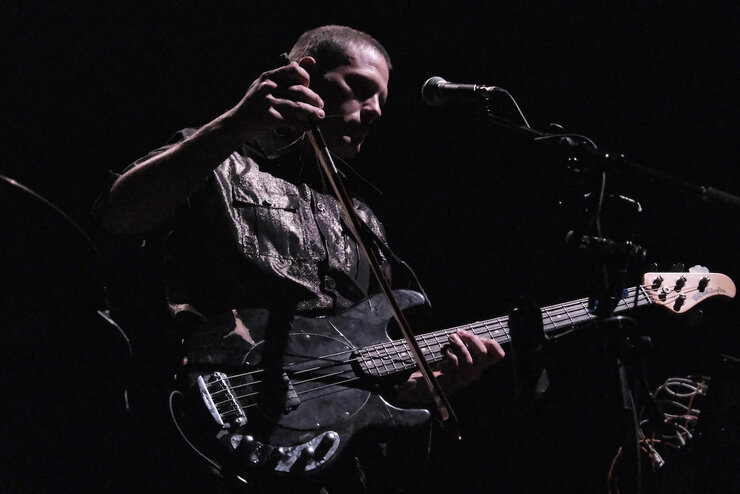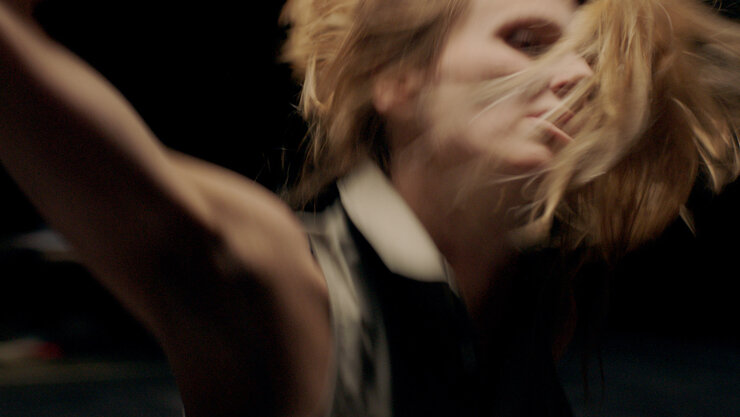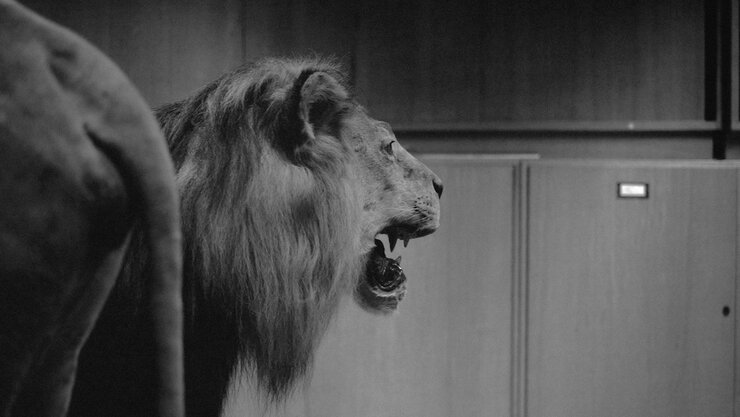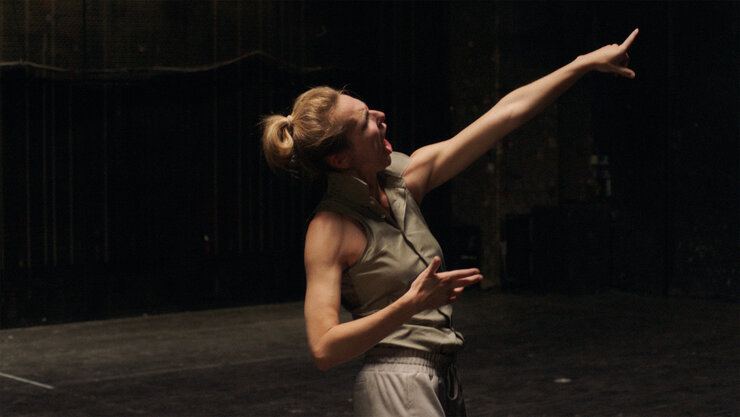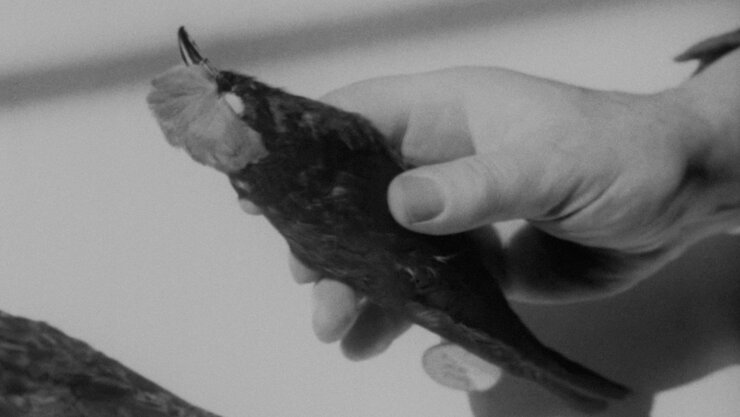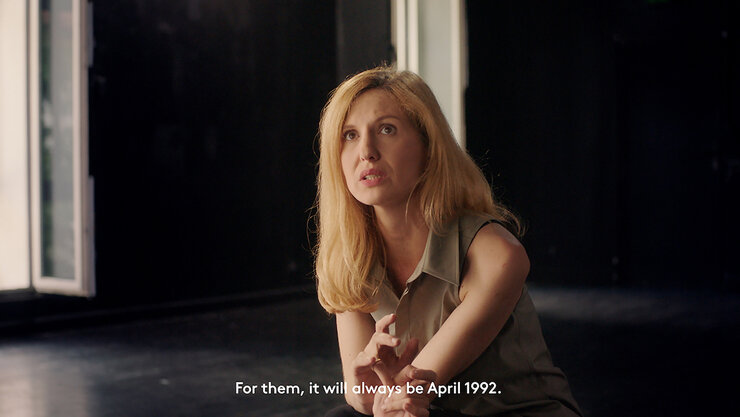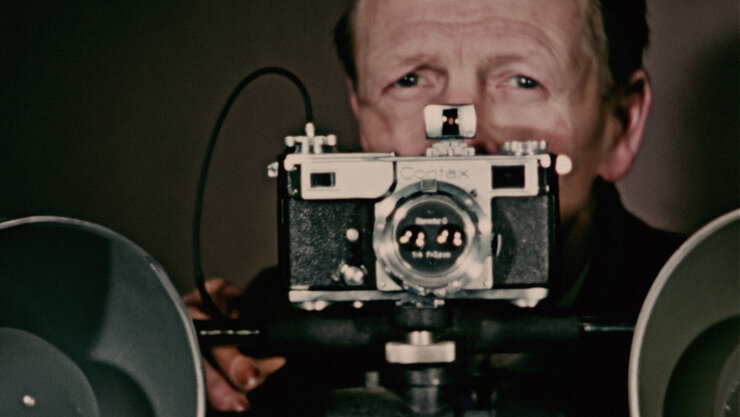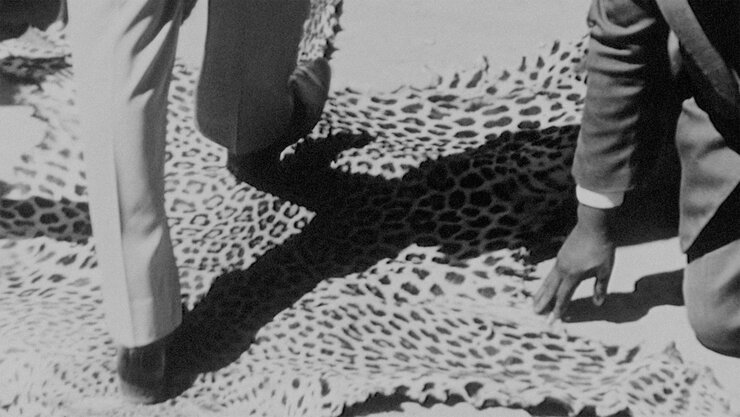«It is not a case of memory loss – but a loss of language»
Interview with Jelena Jureša
Visual artist Jelena Jureša's (*1974) latest work, «Aphasia», explores collective memory and complicity through performance. Based on a film and exhibition of the same name, it is a blend of concert performance, club night and installation. The audience is immersed in a particular night at a Belgrade club, during which a woman recognizes the DJ as the war criminal depicted in a famous photograph by Ron Haviv. In prevision of her upcoming shows at Zürcher Theater Spektakel 2023, author Anna Froelicher spoke with Jelena Jureša about the genesis of «Aphasia», how its immersive club-like atmosphere encourages a high involvement of the audience and how the traumas of a post-war society return in loops.
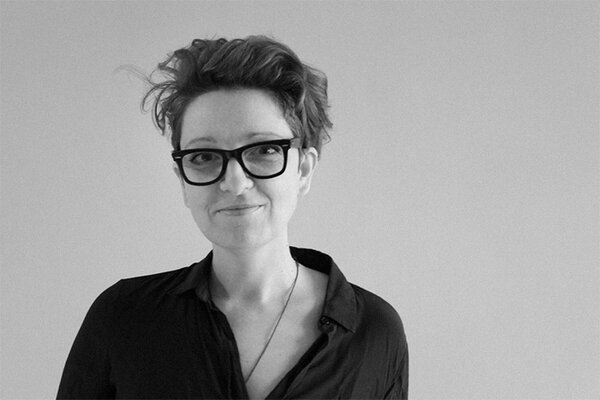
Anna Froelicher: How did you discover the war photograph by Ron Haviv that is the point of departure of «Aphasia», depicting three bodies lying on the floor and three armed men at the start of the Bosnian war and widely known for its ethical controversy?
Jelena Jureša: In the book published on the occasion of the Aphasia film installation and solo exhibition at the ARGOS centre for audiovisual arts in 2019, there is a text referring to the Bijeljina photograph with the title: «I Cannot Remember the First Time I Saw that Photograph.» During the Nineties and the war in Bosnia, when this photograph was published in the U.S., the internet was not really what it is today, so the presence of the photo, especially in Serbia, was not that well known. But besides that, it wouldn't have been possible to publish this anywhere in the Serbian newspapers or on TV during the regime of Slobodan Milošević. So, I really don't remember the first time I saw it. I do remember, though, when there were exhibitions happening in a few Serbian cities in 2002 showing Ron Haviv’s photographs from the Yugoslav wars. I remember the outcry and protest with which these photographs were received in Serbia. There is a wonderful and unsettling documentation in the form of a short film and a book following the exhibition opening in Novi Sad. It was made by Maria Gajicki, one of the directors of Vojvodjanka, a regional women's initiative, who organised Haviv’s exhibition throughout Serbia. You could see most of the men interviewed for the film protesting and in denial about the identity of the perpetrators and the authenticity of the crimes committed. And this cacophony of male protest is intercepted with the face of a young woman who expresses her horror and sadness after encountering these photographs. This film always reminds me of «East of War», a documentary made by Austrian director Ruth Beckerman, interviewing visitors, some of them former soldiers, facing an exhibition of photographs documenting the crimes of the German Wehrmacht.
Why did you decide to create an artistic work around the photograph?
For me this photograph and its reception very much address the question of complicity. I have always been interested in this question, especially as someone living in Serbia at the time of the war. Understanding how fast war circumstances can change us – how one day your neighbour can be your kindest friend and then the next day he becomes your enemy – became almost an obsession of mine. But it was only when I had moved to Belgium in 2014 when I started a conversation with the journalist Barbara Matejčić, who was also doing her research around this photo and the identity of one of the soldiers portrayed. We were excessively exchanging information about that soldier, who is now best known under his alter ego DJ Max. In the picture you see him from the back, a cigarette in his left hand, about to kick a woman, later identified as Ajša Šabanović, lying on the ground. Even though his identity was confirmed in several proceedings in the Hague Tribunal, he – as well as other members of the infamous Arkan’s Tigers – were never brought to justice for the massacre in Bijeljina. I didn't choose to work around this photo just because of its existence. I started working on it because I really wanted to focus on our proximity to perpetrators, questions of complicity, the systems and the circumstances that make them walk free.
In both the film and the performance, you decided not to show the photograph. It is left to the viewer’s imagination. What brought you to that decision?
It was clear from the beginning that I didn't want to show this photograph. There were many reasons for that decision. One of them is not to show the suffering of people who don't have a voice or agency anymore. Many texts have been written and many intellectuals have analysed this photo – I'm not talking about Susan Sontag, who wrote about it extensively in her book, or Jean-Luc Godard, who made a short film –, but actually about the academic communities who remain fascinated by just this one soldier, enchanted by the gruesomeness as well as by the elegance of his act. But what about the identity of the other two soldiers in the background of the photo who are clearly recognisable? For me, the question of what this photograph doesn't show was as equally important as the question of what it does show or what we think it does. On the other hand, I don't need to show the photograph to tackle the dimension of the unforgivable crime committed in and outside the photo.
There is this trope in photography, which you also address in your piece, that «good» images wouldn't need any further explanation, like some kind of unspoken truth. You somehow do the opposite, you don't show the actual picture but you create an experience around it with words and gestures...
This is also my take on any kind of documentary photography; to turn some documentary tropes upside down. Everything in photography is mediated by the one who is taking the photograph, but also by the one who is looking at it. But what is left outside of the frame? Which photograph is the one being published – and vice versa? How does one’s experience influence the way one reads the image? We could always speak about several steps of censorship involved in this process. At the core of this process is always the gaze, a single perspective one imposes on many. Especially in a documentary gesture of any kind, the imperial gaze seems to be impossible to escape. Even if the author works against it: the expectation of the audience to work through it, to receive messages through it, is inevitably there.
Why did you decide to take the existing material of the film and transform it into a performance?
I wanted to go one step further than in the film. I wanted to create a kind of an extra space, a niche, for the things I couldn't speak about within the film. Being fascinated by a piece of war photography also means being complicit as an audience. This is what the scholar Ariella Azoulay describes brilliantly: how we as spectators become somewhat complicit in the society of photography. I'm very much concerned about the question of participation and what it means to take part in something like war. A performative setting with a live audience really opened the possibility for me to work on this question on a formal level, even though the premise of participation can be a tricky one. I wasn’t interested in exploring it directly and being outspoken about it, rather in tackling many levels of participation and translating this thread into an experience. I hoped to integrate the audience, the spectators, as a part of the piece, especially as it had its premiere at Kunstenfestivaldesarts in Brussels. In most European societies the idea of a life without the influence of politics, historical traumas or collective fractures of any kind is regarded as the norm. And that is where privilege lurks, as this is the exception, not the norm at all.
How does your own experience of war contribute to this?
Musicians and composers Alen and Nenad Sinkauz and dancer and performer Ivana Jozić, who take leading roles in «Aphasia», all grew up in Yugoslavia and we belong to the same generation. The horrible events of Yugoslavia’s dissolution marked the way we see and approach the world. I don't think it would have been possible for me to work on this performance, or to collaborate with performers who didn't share a similar experience. It was important that we all knew what we were speaking about, because as a spectator you’re witnessing a translation of this shared experience when you attend the «Aphasia» performance.
During the rehearsals of the performance, the war in Ukraine started. In a way it was to be expected that the media landscape resembled the situation right before the wars in Yugoslavia. But it's very hard to explain within the constraints of an interview how this sensing of something «familiar» actually works. The smell was certainly there.
What was of similar importance to me was the challenge to bring this particular story about war and denial to the Western audience. On one hand, we didn't want to give any introduction to the wars in Yugoslavia, or to offer an instruction, or a didactic device of a similar kind, even though we knew that was expected from us. To sort of fill the gaps, because these histories are outside of the European focus. Furthermore, as a foreigner and a woman, I was more or less prepared that there was a chance that I would not be perceived as a reliable storyteller and therefore all the complexity we had woven into the work could be missed. Instead, we wanted to introduce other ways of dealing with the subject. Storytelling takes place through layered meanings, delivered through music, film, verses and movement, a kind of spiral without a clearly marked beginning and end. It works in loops, the same way trauma does. One can make sense of it, and sometimes cannot.
Trauma often correlates with a loss of the expressible...
That's what the title of my work addresses: «Aphasia», describing the loss of language or the inability to formulate full sentences, is a medical term. But I found this term a very potent analogy, a device to think about what happens if knowledge is there but doesn't find a way out. In a broader sense, in the context of my work, it is the inability to speak about certain topics. When we speak about historical denial, we usually use terms like oblivion or collective amnesia. But in my experience, people usually know what happened. It is not a case of memory loss – but a loss of language.
What about the power structures that regulate what is to be spoken out loud or kept quiet?
In the context of the performance, we set something center stage which is very much ambiguous when it comes to the question of power: music and sound contribute to this with a complex history. On the one hand, music can be a wonderful trigger to bring back all the good memories of some past events. On the other hand, music can be a tool to rebel, to unite – but it can also be a weapon. It is known that in prisons like Guantanamo or Abu-Ghraib, music was used as a form of torture because one cannot really shut one’s ears as sound permeates mostly everything. Without directly inflicting physical pain on someone's body, music is able to infiltrate you, hurt you from the inside.
In our case we wanted to stage music as a kind of tool to speak about populism on an experiential level. Like populism, music can be seductive, it gives you a feeling of understanding – it doesn't need many words, you can just move and belong. There is a collective body that is created through populism and music. During the wars in Yugoslavia in the Nineties, there was a certain ideology that was popularised through the musical genre of turbo-folk. Many would find that it was very complicit in the violence, the politics of oblivion and denial permeating Serbia today. But DJ Max didn't play turbo-folk in the clubs in Belgrade – he played techno music, and he is often described as a pioneer of techno and Goa trance in Serbia. So, the so-called monster, the Arkan's Tiger, performed in well-known Belgrade clubs – and played music for those who would later remember that they gathered to protest against the regime and while dancing themselves into oblivion. Instead, they danced to the music of a criminal. I also find this kind of a cultural snobbism interesting: if you listen to that sort of music, you have a more progressive mindset than those who listen to something like turbo-folk.
You decided to have a female dancer embodying masculine gestures of supremacy, like the choreography of DJ Max as a soldier – or the choreography of a male DJ playing massive tunes in front of a crowd. Is there a different relationship to guilt from a female perspective?
When it comes to the question of denial, I think this is inextricably linked to patriarchy and a difference in female and male perspectives. But otherwise, I couldn't generalise that. During the war, women and children are victims, always – but men as well. So, I wouldn't dare to think in these terms. Having a female performer on stage was an obvious choice, which came organically from the choice of the performer in the film. The film was very precise when it comes to male and female experience. The film opens with a voice that undoubtedly belongs to a white male narrator – something we already recognise as a documentary trope. It's clearly an omniscient author position. But during the first chapter, this voice becomes increasingly aphasic, almost hysteric. In the last chapter, however, a woman is in front of the camera, taking this role. Not only through her voice, but through her gestures and her silent pauses. The film ends with Ivana Jozić's movement and sound. It was important to offer a language that deals with a different model of storytelling.
Jelena Jureša shows her piece «Aphasia» at the Zürcher Theater Spektakel 2023.
